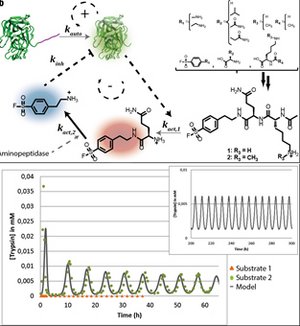CeNS Colloquium
Place: Seminarraum H537, Fakultät für Physik, Schellingstr. 4
Date: 10.10.2014, Time: 15:30h
Synthesis of out-of-equilibrium oscillating chemical reaction networks
Wilhelm T. S. Huck
Radboud University Nijmegen
System-level functions of living systems, such as homeostasis, bistability, and temporal pattern formation, are controlled by complex chemical reaction networks (CRNs) whose characteristics transcend the properties of individual molecules and reactions. Despite substantial efforts in the engineering of complex molecular systems, the construction of functional out-of-equilibrium networks that take advantage of the versatility of synthetic chemistry remains a major challenge. Here, we present a versatile strategy for 'synthesizing' programmable enzymatic reaction networks in microfluidic flow reactors that exhibit sustained oscillations.

Figure 1 Retrosynthetic design and experimental assembly of a flow-based enzymatic oscillator. top)) Detailed reaction diagram of the CRN. Autocatalytic production of Trypsin (Tr) from the proenzyme tryspinogen (Tg) is followed by enzymatic cleavage of a lysine residue on a N-acetylated proinhibitor (1 or 2) resulting in a masked 4-[2-aminoethyl]benzenesulfonyl fluoride (ABF) fragment conjugated to a hydrophilic glutamine (gln) residue. Enzymatic cleavage of gln by aminopeptidase results in the highly reactive ABF inhibitor. bottom) Concentration of Tr in time measured by assembling the complete network under flow conditions and employing two chemically distinct proinhibitors. Solid lines represent the estimated concentration of tryspin obtained by non-linear least-square analysis of the data using a deterministic ODE model.

